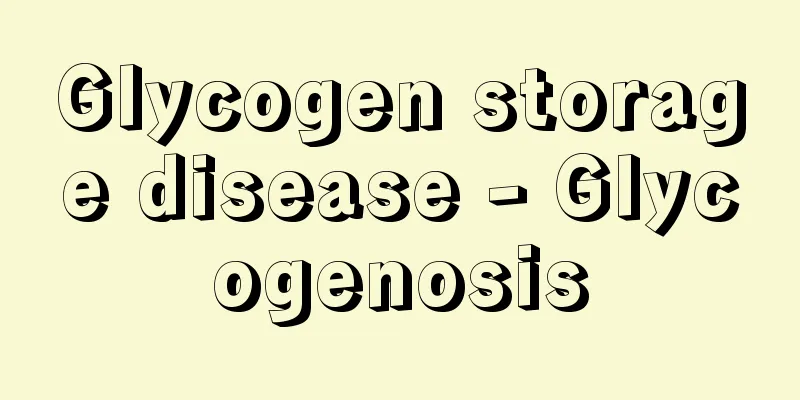Glycogen storage disease - Glycogenosis

What is the disease?Glycogen, like fat, is one of the stored energy sources in the body, and is stored in large amounts in the liver and muscles. When you are fasting, glycogen in the liver is broken down into glucose and released into the blood, which is then used throughout the body. Glycogen in the muscles is broken down during exercise, which requires a large amount of energy in a short period of time, and used by the muscles. Glycogen storage diseases are diseases in which the utilization of glycogen is impaired, resulting in abnormal accumulation of glycogen in tissues. There are about 10 types of the disease, and depending on the tissues in which glycogen accumulates, they are classified as liver (hepatic type), muscle (muscle type), liver and muscle ( What is the cause? The majority of cases are caused by genetic abnormalities in various enzymes involved in the breakdown of glycogen. How symptoms manifest In the hepatic type, the main symptoms are hypoglycemia, liver enlargement (swelling and becoming larger), and short stature. Glucose produced from glycogen in the liver is released into the blood and used by various tissues (especially the brain). Hypoglycemia impairs brain function, causing a range of symptoms from mild to severe. In adulthood, it is benign. In the muscular type, symptoms include fatigue during strenuous exercise, muscle weakness, muscle pain, and myoglobinuria (brown urine) due to muscle breakdown. In the hepatic muscle type, symptoms of both are seen, while in the myocardial type, the heart becomes enlarged and symptoms of heart failure appear. Testing and diagnosisIt is diagnosed based on symptoms, MRI and CT of liver and muscles, the stress test established by Fernandez et al., confirmation of glycogen accumulation by liver and muscle biopsy, measurement of enzyme activity in blood, liver and muscle tissue, etc. Recently, a disease type that can be easily diagnosed by genetic analysis has also become known. Treatment methodsFor hepatic type, the goal is to maintain blood sugar levels by giving special milk and meals in frequent divided portions. If nighttime hypoglycemia is a problem, tube feeding may be used or cornstarch may be given before bedtime or at night. Depending on the type of disease, lactose, galactose, fructose, etc. may be restricted. For muscular type, avoiding strenuous exercise and a high-protein diet may be effective. Liver transplants are effective treatments for hepatic type, and heart transplants are effective for severe myocardial type. What to do if you notice an illnessYou should see a doctor who specializes in inborn errors of metabolism. Kiyoshi Hayasaka Glycogen storage disease |
どんな病気か糖原(グリコーゲン)は、脂肪と同様に体のなかの貯蔵エネルギーのひとつであり、とくに肝臓と筋に多く蓄えられています。肝臓の糖原は、空腹時にブドウ糖にまで分解されて血液中に放出され、全身で利用されます。筋の糖原は、短時間に大きなエネルギーを要する運動時に分解され、筋で用いられます。 糖原病は、糖原の利用が障害され、結果として組織に糖原が異常に蓄積する病気です。10種前後の病型があり、蓄積する組織にしたがって肝臓(肝型)、筋(筋型)、肝臓と筋( 原因は何か 糖原の分解に関係する各種酵素の遺伝子異常が原因で、大部分は 症状の現れ方 肝型では、低血糖、肝臓の腫大(はれて大きくなる)、低身長などが主な症状です。肝臓の糖原から生成されたブドウ糖は血液中に放出され、各組織で(とくに脳など)で利用されます。低血糖になると脳のはたらきが障害され、頭がぼーっとする程度の軽いものから 成人後には良性の 筋型では、激しい運動時の疲労、筋力の低下、筋肉痛、筋の崩壊によるミオグロビン尿(褐色尿)などが認められます。 肝筋型では両者の症状が認められ、心筋型では心臓が拡大し、心不全の症状を示します。 検査と診断症状、肝・筋のMRIやCT、フェルナンデスらにより確立された負荷試験、肝・筋生検による糖原の蓄積の確認、血液、肝、筋組織を用いた酵素活性の測定などにより診断されます。最近では、遺伝子解析により簡単に診断される病型も知られています。 治療の方法肝型では、特殊ミルクや食事を頻回に分けて与え、血糖の維持を図ることが目標になります。夜間の低血糖が問題になる場合には、経管栄養を施したり、就寝前や夜間にコーンスターチを与えます。病型によっては、乳糖、ガラクトース、果糖などを制限します。筋型では、激しい運動を避け、高蛋白食が有効なこともあります。なお、肝型では肝移植、重症心筋型では心移植が有効な治療法です。 病気に気づいたらどうする先天性代謝異常症を専門とする医師の診察を受ける必要があります。 早坂 清 糖原病
|
>>: Dou Jian-de; Tou Chien-tê (English spelling)
Recommend
Agreement of the People
...Hopeful of the possibility of persuasion throu...
kaba türkçe (English spelling)
… [Society, Economy, Culture] The social hierarch...
Inugami Prefecture
…In July 1871, the feudal domains were abolished ...
quinta essentia (English spelling) quintaessentia
...In modern thinking, only the fifth element is ...
Kita-Arima [town] - Kita-Arima
An old town in the southern part of the Shimabara ...
Afyon
...The capital of the province of the same name, ...
The Thule Society
A secret society founded in Munich, Germany in 191...
Liver damage
...There is cirrhosis that develops primarily fro...
Usu-daiko dance
〘 noun 〙 Folk dance. For rain-making ceremonies an...
Dependency theory
A world economic theory that has been advocated si...
Ouchi-nuri
A regional brand of Yamaguchi Prefecture, Chugoku ...
Jingdezhen Pottery Records (English: Jing-de-zhen-tao-lu)
A Chinese book on pottery. Written in 1815 during ...
Blackcurrant - Cabbage
Scientific name: Cayratia japonica Plants. Perenni...
classic migraine
...There are several types of migraine based on s...
The Great Society
…After Walras, politics came to be linked to the ...

![Kokubunji [city] - Kokubunji](/upload/images/67cb916eef935.webp)




![Catherine [I] - Catherine](/upload/images/67cb0507de88f.webp)

![Lake Kasumigaura [town] - Kasumigaura](/upload/images/67cb3488bc7c4.webp)
